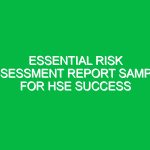Introduction
In the realm of Health, Safety, and Environment (HSE) management, the ability to identify, assess, and mitigate risks is paramount. A risk grid template serves as a vital tool in this process, allowing organizations to visualize potential Hazards and prioritize their responses. By providing a structured framework for analyzing risks, a well-designed risk grid template enhances decision-making capabilities, promotes Safety, and ensures environmental compliance.
The significance of a risk grid template cannot be overstated. It not only assists in the systematic identification of risks but also facilitates communication among stakeholders, ensuring that everyone is on the same page regarding Safety protocols. This article explores the key aspects of a risk grid template within the HSE context, detailing its components, benefits, best practices, and real-world applications.
Understanding the Risk Grid Template
At its core, a risk grid template is a visual representation of risks categorized by their likelihood of occurrence and the severity of their impact. Typically, the grid consists of two axes: the vertical axis represents the probability of a risk occurring, while the horizontal axis represents the potential consequences or severity of that risk.
Key Components of a Risk Grid Template
- Risk Identification: The first step in utilizing a risk grid template is to identify potential risks. This could include anything from chemical spills to equipment failures.
- Risk Assessment: Once risks are identified, they need to be assessed based on their likelihood and potential impact. This assessment often uses a scale (e.g., low, medium, high) to categorize risks.
- Risk Prioritization: The grid allows organizations to prioritize risks based on their severity and likelihood, facilitating a focused approach to risk management.
- Action Plan Development: For each identified risk, organizations can develop specific action plans to mitigate or eliminate the risk.
- Monitoring and Review: A risk grid template is not a static document. Regular reviews and updates are necessary to reflect any changes in the operational environment.
Benefits of Using a Risk Grid Template
Using a risk grid template provides numerous Benefits, including:
- Enhanced Clarity: The visual format of a risk grid makes it easier for stakeholders to understand risks and their implications.
- Improved Decision-Making: By clearly outlining risks and their potential impacts, organizations can make informed decisions regarding resource allocation and Safety Measures.
- Streamlined Communication: The template serves as a common reference point for discussions about risks, fostering collaboration among teams.
- Regulatory Compliance: Many industries face stringent Regulations regarding risk management. A risk grid template aids in demonstrating compliance with these regulations.
Implementing a Risk Grid Template in HSE Management
To effectively implement a risk grid template within an organization, several Best Practices should be considered:
1. Engage Stakeholders
Involve employees at all levels in the risk identification process. Their insights can be invaluable in recognizing potential Hazards that management might overlook. For instance, during a safety workshop, employees from various departments can share experiences related to near misses or unsafe conditions, enriching the grid with real-world data.
2. Tailor the Template to Specific Needs
Every organization is unique, so it is crucial to customize the risk grid template to reflect the specific risks associated with the industry and operational environment. For example, a construction company might have different risk factors compared to a chemical manufacturing plant.
3. Use Clear Definitions
Ensure that all terms used in the risk grid are clearly defined. This eliminates ambiguity and ensures that everyone interprets the risks in the same way. For instance, define what constitutes “high severity” to avoid misunderstandings during risk assessments.
4. Regular Updates
A risk grid template should be a living document. Schedule regular reviews to update the grid based on changes in operations, regulations, or emerging risks. This practice not only keeps the risk grid relevant but also reinforces a culture of safety within the organization.
5. Training and Awareness
Conduct Training sessions to familiarize employees with the risk grid template and its importance in HSE management. Understanding how to use the template effectively empowers employees to contribute to the risk management process actively.
Case Study: Risk Grid Template in Action
Consider the case of a mid-sized manufacturing company that implemented a risk grid template to address safety concerns regarding machinery Operation. After conducting a series of workshops, the team identified several risks, including equipment malfunctions and operator errors.
Using the risk grid, they categorized these risks based on their likelihood and potential impact. For instance, while equipment malfunction was rated as high severity due to the potential for severe injuries, it had a medium likelihood based on Maintenance schedules. In contrast, operator error, while having a slightly lower impact, was deemed high in likelihood due to inadequate training.
By implementing targeted training programs and enhancing maintenance protocols, the company significantly reduced incidents over the following year. The risk grid not only helped prioritize these actions but also served as a communication tool to keep everyone informed about Safety Measures and expectations.
Regulations and Standards Impacting Risk Grid Templates
Several regulations and standards govern risk management practices in the HSE context. Familiarity with these guidelines is essential for organizations looking to implement effective risk grid templates.
1. Occupational Safety and Health Administration (OSHA)
In the United States, osha sets standards for Workplace Safety. Compliance with OSHA regulations often requires organizations to conduct risk assessments and implement measures to mitigate identified risks. A risk grid template can assist in documenting these assessments and the corresponding actions taken.
2. ISO 45001
This international standard outlines the requirements for an Occupational Health and safety management system. It emphasizes the importance of risk assessment and outlines a systematic approach to managing workplace risks. A risk grid template aligns well with the principles of ISO 45001, providing a structured method for risk evaluation.
3. Environmental Protection Agency (EPA)
For organizations involved in environmentally sensitive operations, compliance with EPA regulations is crucial. A risk grid template can help identify environmental risks and ensure that appropriate measures are in place to mitigate them, thus promoting Sustainability and compliance with legal requirements.
Conclusion
In conclusion, the risk grid template is an essential tool for effective HSE management. It provides a structured approach to identifying, assessing, and prioritizing risks, thereby enhancing decision-making and promoting a culture of safety within organizations. By customizing the template to fit specific needs, engaging stakeholders, and adhering to regulatory standards, organizations can significantly improve their risk management processes.
As industries continue to evolve, the importance of proactive risk management cannot be understated. The integration of a risk grid template into HSE practices not only protects employees and the environment but also fosters a culture of continuous improvement. Organizations are encouraged to adopt this valuable tool and make it an integral part of their health, safety, and environmental strategies.


